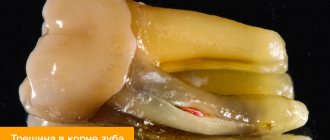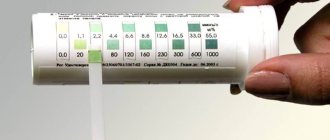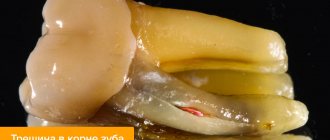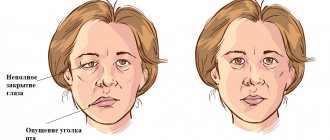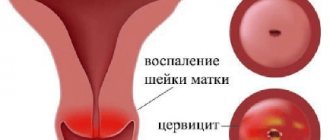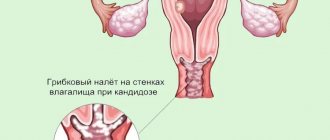Vegetative dystonia has many manifestations, for example, some patients experience numbness in the tongue due to VSD, a sore throat or disturbances in the processes of digestion and breathing. Many patients with numbness in the limbs, head or tongue use remedies to eliminate these symptoms, but they do not completely get rid of the problem.
Effective treatment of vegetative-vascular dystonia is based on eliminating the causes of the disorder. Thus, modern specialists have developed a set of methods to relieve nervous tension and reduce the production of adrenaline, which is one of the causes of unpleasant sensations. Neurologists, psychotherapists, cardiologists, and exercise therapy instructors provide high-quality treatment for VSD, which has various manifestations.
Numbness of the tongue
When the functions of the autonomic nervous system are disrupted, blood pressure changes, muscle tone increases, and blood vessels narrow. The resulting spasms lead to the tongue going numb during VSD. The cause of discomfort may be excessive production of adrenaline by the adrenal glands.
Numbness of the tongue can occur due to emotional stress, compression of blood vessels due to cervical osteochondrosis, as well as pathologies of the cardiovascular system. The patient's condition with VSD worsens as a result of worries due to numbness of the tongue and face. To normalize psycho-emotional standing and treat VSD, you should contact a specialist who will select safe and effective means.
Neurologists at the Yusupov Hospital have extensive experience in treating various types of vegetative-vascular dystonia. When a patient comes in with complaints of numbness of the tongue, a feeling of a lump in the throat, a diagnosis is carried out. The main diagnostic methods for VSD are:
- general examination of the patient;
- blood and urine tests;
- palpation;
- Magnetic resonance imaging.
Treatment of VSD at the Yusupov Hospital is carried out according to an individual program, which is developed by highly qualified specialists.
Causes of stroke
Depending on the cause of cerebrovascular accident, ischemic and hemorrhagic strokes are distinguished.
Ischemic stroke occurs as a result of blockage of cerebral vessels by a blood clot, when gradually less and less blood flows to an area of the brain. Hemorrhagic stroke develops as a result of rupture of a vessel and hemorrhage in the brain tissue, as a result of which the blood supply to its area abruptly stops. Hemorrhage can be into the subarachnoid space (SAS) or directly into the cerebral substance (ICH). The ratio of ischemic and hemorrhagic strokes is 4-5:1 [4].
Pathologically, a stroke can be cardioembolic, lacunar, atherothrombotic, or another, including unknown, etiology (TOAST classification) [10].
Predisposing factors:
- men from 45 to 59 years old;
- age 70 years and older (for both sexes) [4];
- arterial hypertension;
- atrial fibrillation;
- atherosclerosis of cerebral vessels;
- coagulopathy, thrombophilia, anemia;
- arteriovenous malformations;
- osteochondrosis with damage to the vertebral artery;
- brain tumors;
- dyslipoproteinemia;
- obesity;
- diabetes;
- intermittent claudication;
- mechanical prostheses of heart valves and blood vessels;
- IHD, myocardial infarction less than 6 months before the stroke;
- other cardiac diseases;
- smoking, alcoholism;
- family history of stroke;
- sedentary lifestyle;
- stress [1, 3].
Sore throat
Discomfort and sore throat with VSD occurs due to spasms of the muscles of the pharynx and larynx. If patients feel a lump in the throat during VSD, an experienced neurologist at the Yusupov Hospital will tell you how to get rid of this symptom.
A sore throat occurs in patients with VSD during the daytime. Many people experience serious stress when this symptom appears, as they consider discomfort in grief to be a manifestation of dangerous diseases, such as a malignant tumor or goiter of the thyroid gland. To eliminate throat discomfort, many people prefer to drink water, which brings temporary relief, but to completely eliminate the symptom, it is necessary to get rid of the root cause.
Diagnosis and treatment of psychogenic dizziness
Dizziness is one of the most common symptoms in neurological and general somatic practice. Complaints of dizziness rank third after complaints of headache and back pain. First of all, you must remember that dizziness is just a symptom and not an independent disease. It can be a manifestation of various sufferings - cardiovascular, endocrine, mental, diseases of the spine, brain, etc., in total there are about 80 different nosological forms. Determining the causes of dizziness and its treatment require a multidisciplinary approach, and sometimes the use of complex equipment. Due to these objective difficulties, no more than 20% of patients receive a correct diagnosis and adequate treatment [1].
The head of a large otoneurological clinic in Germany and the author of the famous monograph “Dizziness,” Thomas Brandt, cites in it the most common causes of dizziness. Psychogenic dizziness, including paroxysmal phobic dizziness, ranks second after benign paroxysmal dizziness (Fig. 1).
The cause of psychogenic dizziness can be any mental illness, but most often anxiety disorders.
Diagnosis of psychogenic dizziness
Psychogenic dizziness refers to vague sensations described as dizziness, which most often occur in neurotic, stress-related disorders.
Diagnosis of psychogenic dizziness includes two sequential and mandatory stages.
The first stage is a negative diagnosis aimed at excluding all other possible causes of dizziness:
- damage to the vestibular system at any level;
- somatic and neurological diseases accompanied by lipothymia;
- neurological diseases accompanied by impaired walking and balance.
This requires a thorough examination of the patient, in some cases with the involvement of otoneurologists, cardiologists, hematologists, etc., as well as a thorough paraclinical study.
Thus, when examining a patient with dizziness at the first stage, it is important to determine the type of dizziness. To do this, you should carefully collect anamnesis - ask the patient in detail what he means by the word “dizziness.” With vestibular, systemic, true vertigo or vertigo, the patient experiences an illusory sensation of movement of a stationary environment in any plane, as well as a sensation of movement or rotation of his own body. The cause of systemic dizziness is damage to the vestibular analyzer at the peripheral or central level.
Psychogenic dizziness is always non-systemic in nature. The patient describes any sensations other than rotation: fog in the head, instability, fear of falling, and others.
When making a differential diagnosis, it is also extremely important to identify and clarify the nature of concomitant somatic and neurological manifestations to exclude other “organic” causes of non-systemic dizziness. For this purpose, a study of nystagmus, balance tests, audiography, computed tomography (CT) or magnetic resonance imaging (MRI), Doppler ultrasound of the main arteries of the head, compression-functional tests, radiography of the skull, internal auditory canal, cervical spine, complete blood count, fasting blood sugar, blood urea nitrogen and other studies [4].
The second stage is a positive diagnosis of neurotic disorders associated with stress.
Among emotional disorders, the most common cause of dizziness is anxiety or anxiety-depressive disorders. It is the frequency of anxiety, which is the most common emotional disorder and is observed in 30% of the population, that determines the high prevalence of psychogenic dizziness.
The clinical picture of anxiety disorders consists of mental symptoms, the most common of which are anxiety, worry about trifles, a feeling of tension and stiffness, as well as somatic symptoms, mainly caused by increased activity of the sympathetic division of the autonomic nervous system. One of the commonly observed physical symptoms of anxiety is dizziness and lightheadedness. The combination of mental and physical symptoms is not accidental - when the body is threatened or there is any potential threat, preparation occurs to fight the danger or flee from it. These changes in the body are ensured by the autonomic nervous system, which is a potential “bridge between the psyche and soma.” The most common symptoms of anxiety are presented in Fig. 2, 3.
Purely anxiety disorders are relatively rare in clinical practice. In most cases, in 70% of patients, anxiety disorders are combined with depressive disorders. The mental symptoms of anxiety and depression are largely similar and overlap. The comorbidity of the two most common mental disorders is determined by common biochemical roots—the role of serotonin in the pathogenesis of both conditions is discussed. The high effectiveness of both tricyclic antidepressants (TCAs) and some selective serotonin reuptake inhibitors (SSRIs) for both anxiety and depression confirms that serotonin has both anxiolytic and antidepressant effects. Finally, with the long-term existence of anxiety disorders, the patient inevitably develops a feeling of complete spiritual paralysis and depression develops. The onset of depression is accompanied by symptoms such as chronic pain disorder, weight loss, sleep disturbances, and others, which can increase symptoms of anxiety. Thus, a vicious circle develops: the prolonged existence of anxiety causes the development of depression, and depression increases the symptoms of anxiety. The high frequency of comorbidity of anxiety and depression is taken into account in the latest classifications - a special subgroup has been identified within anxiety states - mixed anxiety-depressive disorder.
According to ICD-10, there are four types of anxiety disorders: anxiety disorders (generalized anxiety disorder, mixed anxiety-depressive disorder, panic disorder); phobic anxiety states (simple phobias, social phobia, agoraphobia); obsessive-compulsive disorder; reactions to a stressful stimulus (simple reactive disorder, post-stress reactive anxiety disorder).
The feeling of dizziness most often occurs in patients with generalized anxiety disorder. In this case, the patient suffers from constant unjustified or exaggerated fears for his family, health, work or material well-being. At the same time, an anxiety disorder is formed regardless of any specific life event and, thus, is not reactive. In such a patient, at least six of the common anxiety symptoms listed above may be observed every or almost every day for more than six months—the “rule of six.”
A patient with generalized anxiety, when visiting a neurologist, rarely reports mental symptoms, but, as a rule, presents a lot of somatic (vegetative) complaints, where dizziness can be the leading symptom, or actively presents the only complaint of dizziness. This happens because the patient is most alarmed by the feeling of dizziness, thoughts of a stroke or other serious brain disease arise, mental disorders - fear, impaired concentration, irritability, wariness, etc. are regarded as a reaction to severe, currently not identified illness. In other cases, mental disorders are mild, and the clinical picture is actually dominated by dizziness. The latter option is especially common in cases where anxiety disorders occur in patients with congenital vestibulopathy. Such people have an imperfect vestibular apparatus since childhood. This is manifested in their poor tolerance to transport (sickness), poor tolerance to heights, swings and carousels. In an adult, these symptoms are less relevant; over the years, the vestibular apparatus is trained and vestibular disorders are compensated, however, when anxiety occurs, various sensations may arise - instability, fog in the head, etc., which are interpreted by them as dizziness.
One of the most important features of psychogenic dizziness is its combination with disorders in other systems, since the somatic manifestations of anxiety are always multisystemic (
). The ability of a doctor to see, in addition to complaints of dizziness, the disorders that naturally accompany it in other systems, allows us to understand its clinical essence and determine its psychosomatic (vegetative) nature [7]. For example, dizziness in generalized anxiety disorder is often associated with increased breathing (hyperventilation syndrome), in which, due to excessive blood oxygen saturation and hypocapnia, presyncope, paresthesia, muscle spasms or cramps, cardialgia associated with increased tone of the pectoral muscles may develop. as a result of increased neuromuscular excitability, tachycardia, etc. To identify polysystemicity, it is necessary to actively ask the patient about the presence of other complaints and disorders in addition to dizziness.
Psychogenic dizziness can also be one of the main symptoms of panic disorder. It is characterized by the recurrence of panic attacks and anxiety in anticipation of the next attack. The diagnosis of a panic attack is characterized by the presence of emotional disorders, the severity of which can range from a feeling of discomfort to panic and other mental or somatic symptoms - at least 4 out of 13, among which one of the most common is dizziness. Dizziness in the picture of a panic attack can occur spontaneously, without any apparent reason, in the words of patients - “out of the blue.” However, in more than half of the cases, it is possible to find out that dizziness arose after emotional stress or fear experienced by the patient, especially for the very first and, as a rule, the most severe attack.
A special type of phobia is phobic postural vertigo. It is described by patients as instability in the form of attacks (seconds or minutes) or a feeling of an illusory violation of the body’s stability lasting a fraction of a second and can occur spontaneously, but is more often associated with special perceptual stimuli (overcoming a bridge, stairs, empty space) [2].
The most demonstrative is psychogenic dizziness in patients suffering from agoraphobia. At home, surrounded by relatives or a medical facility, the patient may not experience dizziness or it may be mild (serve himself, do housework without difficulty). A neurological examination does not reveal any walking or balance disorders in such a patient when special tests are carried out. When moving away from home, especially in transport, in the subway, dizziness, gait disturbance, instability, suffocation, heart pain, tachycardia, nausea, etc. occur.
In all of these cases, dizziness is a symptom, a manifestation of one or another type of anxiety disorder.
Thus, the following clinical features of psychogenic dizziness can be distinguished:
- Dizziness is intermittent and has been described as “brain fog,” a feeling of mild intoxication, or a fear of falling. Fluctuating instability in the form of attacks (seconds or minutes) or a sensation of an illusory violation of the body’s stability lasting a fraction of a second is possible.
- Dizziness appears spontaneously, but is often associated with specific perceptual stimuli (bridge, stairs, empty space) or situations that are perceived by the patient as provoking factors (subway, department store, meeting, etc.).
- Dizziness and complaints occur in a standing position and while walking, despite the normal performance of stability tests such as the Romberg test, tandem walking, standing on one leg, etc. With psychogenic dizziness, a significant decrease in staggering in the Romberg position is often noted when distraction - psychogenic Romberg.
- The cardinal clinical sign of psychogenic dizziness is its combination with disorders in other systems (polysystemic), which indicates its secondary psychosomatic (vegetative) nature.
- The onset of the disease follows a period of fear or emotional stress and often occurs in individuals with vestibulopathy (congenital deficiency of the vestibular apparatus).
- Anxiety and anxiety-depressive disorders accompany dizziness, although dizziness can occur without anxiety.
- There are no objective clinical and paraclinical signs of organic pathology.
Psychogenic dizziness occurring after benign paroxysmal vertigo
Benign paroxysmal vertigo (BPV) is the most common type of vertigo. Its cause is cupulolithiasis - the formation of deposits (detritus) in the semicircular canals of the inner ear, which irritate the receptors as they move and cause severe vestibular vertigo. When changing body position, often when getting out of bed or turning the head, the patient experiences a feeling of strong rotation, lasting from several seconds to a minute and accompanied by nausea, vomiting and other vegetative symptoms. To diagnose BPH, the Hallpike test is used. The patient turns his head 30 degrees to the side and moves from a vertical to a horizontal position with his head slightly tilted back. At the same time, he experiences severe systemic dizziness and nystagmus. The disease is benign, but is prone to relapse. To treat it, special Epley positional techniques are used, the task of which is to mechanically remove detritus from the posterior semicircular canal of the inner ear, after which the dizziness stops.
An attack of BPH is always difficult for the patient, can be repeated when turning the head, chains him to bed, and forces him to take a forced position. Undoubtedly, DPG is a stress-generating factor, is accompanied by fear and can provoke reactive anxiety disorder in an emotionally labile person. In some cases, the anxiety disorder that develops following DPG is iatrogenic. Doctors often misdiagnose patients with BPH as acute cerebral circulatory disorders in the vertebrobasilar system, hospitalize them, and conduct massive courses of vascular therapy, thereby convincing the patient of the severity of his condition and the presence of a fatal disease. In such frequent cases, the patient develops an anxiety disorder as a reaction to a severe neurological disease. Dizziness becomes unsystematic (instability, fear of falling, fog in the head, etc.), acquires a constant course, periodically intensifying. In such cases, both negative and positive diagnosis of psychogenic dizziness are especially important. A Hallpike test is mandatory. It must also be remembered that acute cerebrovascular accidents (ACVA) in the vertebrobasilar system, in addition to dizziness, are necessarily accompanied by other signs of damage to the brain stem: oculomotor, bulbar, sensory and other disorders.
Treatment of psychogenic dizziness
In the treatment of psychogenic dizziness, complex therapy is used, combining both non-drug and medicinal treatment methods [7].
Non-drug treatments include:
1) vestibular gymnastics, aimed at training and reducing the excitability of the vestibular apparatus; 2) breathing exercises: transition to the abdominal type of breathing, in which exhalation is twice as long as inhalation. Such breathing exercises reduce hyperventilation disorders comorbid with psychogenic dizziness. To relieve severe hyperventilation disorders, during a hyperventilation crisis, breathing into a paper or plastic bag can be recommended; 3) the most effective method of treatment is psychotherapy.
Medicinal methods.
1) Psychotropic therapy has priority in the treatment of psychogenic dizziness.
The first-line drugs for the treatment of anxiety disorders are antidepressants - SSRIs, Paxil and Fevarin have an anxiolytic effect; tricyclic antidepressants (amitriptyline) are used less frequently due to the presence of a large number of side effects and poorer tolerability. Traditional anxiolytics are benzadiazepines (Phenazepam, Diazepam, Alprazolam, Clonazepam, etc.). In some cases, a positive effect in the treatment of anxiety disorders is achieved with the use of “small” antipsychotics (sulpiride, tiapride, thioridazine), usually using small doses.
The drug Atarax (hydroxyzine) has shown pronounced effectiveness against psychogenic dizziness developing as part of generalized anxiety disorder. Atarax is an H1-histamine receptor blocker. It has a pronounced anti-anxiety, antihistamine, antipruritic and antiemetic effect. In a study conducted at our department, prof. Solovyova A.D., it was shown that in patients with vegetative dystonia syndrome, which is the main neurological manifestation of generalized anxiety disorder, complaints of dizziness and lipothymic (presyncope) states decreased by almost 80%.
2) Additional therapy.
As an additional therapy, the drug Betahistine is used, which reduces the excitability of the vestibular apparatus and is effective for all types of dizziness, including psychogenic.
The effectiveness of Betaserc was tested in patients with psychogenic dizziness using a special computer program developed by the staff of the Institute of Medical and Biological Problems, prof. Kornilova L.N. et al. In a joint study with our department [6], it was shown that the drug objectively improves vestibular reactivity and the state of the oculomotor system (
). A follow-up study revealed that the effectiveness of Betaserc was temporary, so it should be used for a long time for this type of dizziness as an additional therapy, especially in cases where dizziness develops in people with congenital vestibulopathy and acts as a leading somatic symptom.
For questions regarding literature, please contact the editor.
E. G. Filatova , Doctor of Medical Sciences, Professor of the FPPOV MMA named after. I. M. Sechenova, Moscow
Polysystemicity of somatic manifestations of anxiety
. Efficacy of Betaserc in the treatment of psychogenic dizziness
Sweating
Excessive sweating with VSD is a common symptom in which people try to get rid of the problem on their own. Self-medication for vegetative-vascular dysfunction can lead to the development of other manifestations of VSD.
Disorders in the functioning of the nervous system cause excessive sweating, which makes a person feel insecure. A lump in the throat with VSD and other symptoms if left untreated can cause consequences. Thus, with increased sweating, a favorable environment is created for the development of infections. The protective functions of the skin gradually deteriorate, so the skin can be affected by fungus.
To reduce sweating, specialists at the Yusupov Hospital recommend that patients get rid of bad habits, adhere to proper nutrition, and maintain a daily routine. During sessions, psychotherapists at the Yusupov Hospital help patients reduce anxiety and learn to relax.
Suprastin: side effects and symptoms of overdose, dosage for children and adults
The number of allergic diseases in the world is growing every year. Accordingly, the demand for drugs that help effectively combat them is growing. Allergies are widespread due to various reasons - unhealthy diet, environmental pollution, stress and much more.
Suprastin is a drug belonging to the category of chloropyramines; it is a chlorinated analogue of pyribenzamine. This is a first generation antihistamine, belongs to the group of ethylenediamines .
Studies have shown that Suprastin helps well with various allergic pathologies in adults and children, including hay fever. Like other medications, Suprastin has its contraindications and side effects.
Characteristics of antihistamines
This drug belongs to the category of antihistamines. Histamines are biologically active substances that provoke allergies. Histamine causes the following symptoms:
- itching;
- swelling of tissues;
- secretion;
- blood vessels dilate sharply.
Antihistamines cannot reduce the amount of histamine, but they help block tissue receptors that are sensitive to this substance.
Suprastin, like other antihistamines, help eliminate or reduce the following effects of histamines:
- increased tone of smooth muscles in the bronchi;
- increased muscle tone of the uterus and intestines;
- decreased blood pressure;
- capillary permeability increases, which provokes the appearance of edema;
- itching and redness of the skin and mucous membranes.
Suprastin, along with diphenhydramine, also tends to depress the nervous system. Accordingly, it additionally has a hypnotic and calming effect.
Antihistamines are used to treat allergic conditions, they are especially effective for skin lesions and lesions of the mucous membranes, for example:
- Quincke's edema;
- hives;
- conjunctivitis;
- allergic rhinitis.
But if the patient suffers from severe allergic diseases, for example, anaphylactic shock, then such drugs will not be effective.
Characteristics of Suprastin
The antihistamine drug Suprastin also has the non-patented international name chloropyramine. It is available in the form of tablets and injection solutions; the drug suppresses the functioning of histamine receptors , which reduces capillary permeability. The drug has a calming effect, relieves itching and partially relieves bronchospasm.
After taking a tablet or injection, Suprastin is absorbed into the blood, then it is distributed to organs, including the central nervous system. The drug is broken down in the liver, then exits through the kidneys along with the urine. Moreover, in children the drug can be eliminated faster than in adults.
Instructions for use of Suprastin
The use of this drug depends on the form of its release. So, if we are talking about tablets, then they need to be taken with food, cannot be chewed, but they should be washed down with plenty of liquid.
The recommended dosage for an adult is up to 4 tablets per day , for children from 1 month to a year - 2 tablets up to 3 times a day, they are ground well and added to baby food.
From one year to 6 years, children are prescribed 2 pieces or half three times a day. From 6 to 14 years old you need to give 0.5 tablets 2-3 times a day. The dosage is increased if the disease is advanced or if there is no effect.
An overdose should not be allowed; the maximum dose is 2 mg of Suprastin per kilogram of weight.
But Suprastin in the form of an injection solution is administered intramuscularly or intravenously in difficult cases and under strict medical supervision.
The recommended dosage for adults is up to 2 ampoules per day . Suprastin in ampoules is prescribed to children in the following quantities per day:
- 1 month – up to a year – 0.25 ml;
- 1 year – 6 years – 0.5 ml;
- 6 – 14 years – 1 ampoule.
Indications for use of Suprastin
Indications for the use of Suprastin in children and adults are as follows:
- allergic diseases - rash, hives, runny nose and conjunctivitis;
- immediate allergic reactions – angioedema and anaphylactic shock;
- prevention and treatment of allergic manifestations after taking certain medications, as well as insect bites.
Contraindications
To prevent side effects and overdose, Suprastin is contraindicated in the following cases:
- if there is an individual intolerance to this drug;
- with prostate adenoma, when the passage of urine is disrupted;
- for glaucoma;
- children up to one month old;
- during pregnancy;
- when breastfeeding;
- premature babies older than one month;
- while taking MAO inhibitors;
- in acute myocardial infarction or arrhythmia.
Doctors prescribe Suprastin with extreme caution to older people, as well as to patients with liver and heart diseases, exacerbations of erosive and ulcerative diseases of the gastrointestinal tract and urinary retention. While taking the drug, you should not operate machinery or drive vehicles.
Suprastin: side effects
This drug may cause the following side effects:
- from the central nervous system, lethargy, fatigue, problems with coordination of movements, headache, irritation, tremors of the limbs, convulsions, blurred vision and euphoria may be observed;
- effects on the gastrointestinal tract - nausea and dry mouth;
- Other side effects include decreased blood pressure, problems with urination, increased heart rate and heart rhythm disturbances, allergies to sunlight, and increased intraocular pressure. In rare cases, decreased immunity and anemia have been observed.
Suprastin should be taken with extreme caution simultaneously with painkillers and sedatives, as well as antidepressants, since the effects of taking them can be greatly enhanced.
Suprastin: overdose
An overdose of Suprastin manifests itself in the following syndromes:
- The central nervous system is depressed or excited;
- the appearance of hallucinations;
- coordination of movements is impaired;
- pupils dilate;
- convulsions;
- dry mouth;
- increased body temperature;
- loss of consciousness and coma are extremely rare.
To get rid of overdose syndromes and subsequent problems, it is recommended to rinse the patient’s stomach and take about 20 tablets of activated carbon . If the patient's condition does not improve after this, you should immediately call a doctor.
To prevent the occurrence of side effects, as well as overdose, the course of treatment with Suprastin should be prescribed only by a doctor. The specialist chooses the duration independently, depending on the characteristics of the disease and its complexity.
Features of the use of Suprastin for children and pregnant women
Suprastin should not be used to treat premature babies and newborns. It can be given to babies from one month old and to adults. If the child’s allergic reaction is weak, then the drug can be given a maximum of once a day. And in case of a complex form of the disease, Suprastin is prescribed up to 3 times a day.
Sometimes children experience an atypical reaction to the drug , which is expressed by such effects as:
- insomnia;
- anxiety;
- overexcitement.
The duration of treatment of a child with Suprastin is up to a week. If during this period the signs of the disease do not disappear, you should consult a doctor.
If we talk about the use of the drug during pregnancy , then studies on this issue have not yet been carried out in sufficient quantities to say for sure whether this drug harms the fetus or not. Therefore, the decision to use this medicine during this period can only be made by a doctor. But during breastfeeding you will need to stop taking the drug.
Features of using Suprastin
You should know that each tablet of the medicine includes a small amount of lactose monohydrate, but even this is enough for a patient suffering from lactose deficiency to experience side effects. And when used simultaneously with ototoxic drugs, the drug can relieve early manifestations of ototoxicity.
If the patient suffers from liver or kidney diseases, then the dosage will need to be reduced , so you need to warn the doctor in advance about your ailments. At night, while taking Suprastin, the symptoms of reflux-esophigitis may intensify.
At the beginning of treatment, the drug may cause dizziness, drowsiness and severe fatigue. It is not recommended to drive at this time.
Now that we have examined the main features of taking Suprastin, its possible side effects and described what is accompanied by an overdose, it will be easier for you to use it, in addition, you will not forget to warn your doctor about the presence of concomitant diseases.
Source: https://allergo.guru/preparaty/suprastin-primenenie-pobochnye-effekty-i-peredozirovka.html
Advantages of treatment at the Yusupov Hospital
The Yusupov Multidisciplinary Hospital is a modern medical institution that maintains the tradition of attentive treatment and respect for each patient, which is especially important in the treatment of vegetative-vascular dystonia.
During consultations with patients complaining of a lump in the throat due to VSD, specialists from the Yusupov Hospital clearly explain how to get rid of the unpleasant sensations. When treating patients, only proven methods are used, so the services provided meet international standards.
The therapy program, compiled by highly qualified specialists at the Yusupov Hospital, allows patients to be relieved of the main disorder and its manifestations, such as dry throat during VSD, increased anxiety, profuse sweating, numbness of the tongue, disruption of the gastrointestinal tract, and panic attacks.
If you experience discomfort in the throat, numbness of the tongue or other unpleasant symptoms, contact the clinic to determine the cause. Pre-registration for a consultation with specialists allows patients to choose the most convenient time and avoid queues. Make an appointment with specialists at the Yusupov Hospital.
Symptoms of a stroke
Stroke leads to various brain injuries, depending on the location of the lesion and the pathological type of cerebrovascular accident:
- disturbances of movement in the limbs: from restrictions (paresis) to complete paralysis. When the lesion is localized on the right, the left limbs suffer; with a left-sided lesion, right hemiparesis is formed; in some cases, movements in all limbs may stop (tetraparesis or double hemiparesis);
- sensory disturbances on one or both sides;
- speech disorders (dysarthria - poor articulation; aphasia - inability to pronounce and understand words, write and read);
- ataxia (impaired coordination of movements, “overshooting”, unsteadiness, imbalance, tremor);
- visual impairment: from blindness to double vision and gaze paresis;
- hearing impairment and dizziness;
- violation of mental functions (consciousness, thinking, attention, memory, will, behavior);
- paresis of the soft palate and pharynx, swallowing disorders;
- disorders of urination and defecation;
- depression of respiration and vascular tone;
- increased intracranial pressure;
- patients complain of headaches, vomiting, hiccups, yawning, shoulder pain;
- consciousness is gradually depressed to the point of coma [1, 3].
Causes of death may include cerebral edema, pneumonia, heart failure, and recurrent stroke. In severe cases, “locked-in syndrome” may develop: the patient is conscious, but cannot move, swallow or speak [3].
